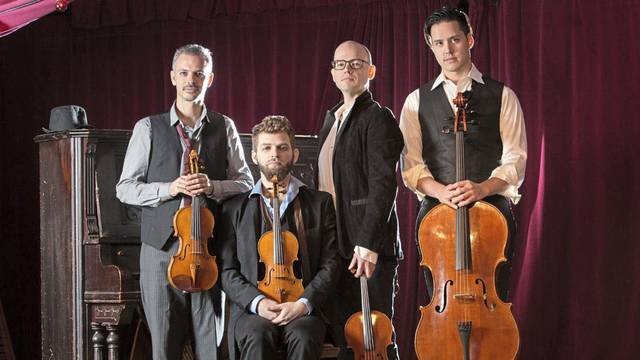Brooklyn Rider string quartet to play new works by women composers
Music and healing will be the unifying theme when Brooklyn Rider makes its much-anticipated return to Pittsburgh on the first Monday in January.
The Brooklyn Rider string quartet will perform “Healing Modes” as part of the Chamber Music Pittsburgh concert series on Jan. 6 in Pittsburgh’s Carnegie Music Hall.
Brooklyn Rider was formed in 2006 by musicians who have known each other since their student days at the Curtis Institute of Music in Philadelphia and The Juilliard School in New York City. Their name expresses kinship with The Blue Rider, a group of artists and musicians in Munich, Germany, before World War I who wanted to break the restraints of tradition.
The group’s programming is so brilliant and imaginative that it has been praised as “the future of chamber music” and for revitalizing the string quartet as “a vital and creative 21st-century ensemble.”
Thanksgiving
The inspiration for “Healing Modes” came from Ludwig van Beethoven’s String Quartet No. 15, which will be the concert’s culmination.
It was written near the end of the composer’s life after he recovered from a serious illness. The slow movement is entitled “A Holy Song of Thanksgiving.”
“A Holy Song of Thanksgiving” will be the centerpiece of Brooklyn Rider’s performance, which also features new commissions from five women composers.
“It just seemed to us that this was a really rich topic for composers of our day to address healing in their personal life or in some aspect of society in need of healing,” says violist Nicholas Cords.
“The joy of doing a commissioning project — all five happened to be women composers, but that wasn’t the plan originally — with open-ended parameters you can be surprised in a good way with the results.”
They were certainly surprised by jazz musician Matana Roberts’ “borderlands …”
“She delivered to us an incredibly beautiful graphic score with six different tableaux to which we were supposed to respond in an improvisatory way,” says Cords. “There are very few places with anything looking like a staff or clef or time signature. It deals with the Mexico border crisis, and the passions felt about that are very much expressed in the piece.”
Desert-island piece
Pulitzer Prize winner Caroline Shaw is a violinist and was excited to be part of the project, because Beethoven’s Quartet No. 15 is one of her desert-island pieces.
The title of her piece, “Schisma,” refers to a phrase in the Bible about God providing protection within a cleft in a rock. The Greek root of the title connects the piece to Syrian refugees seeking refuge in the craggy Greek islands.
Reena Esmail’s “Zeher” (Poison) uses Hindustani vocal music as a “jumping-off point” for her piece. Cords says the composer sent them a recording of her singing parts of her piece as window into the style.
While Beethoven wrote his quartet after he recovered, Gabriella Len Frank wrote “Kanto Kechua #2” in the midst of dealing with a very serious autoimmune disease.
“She has a Peruvian-Chinese background and a lot of her music is inspired by the Incas,” says Cords. “Paradoxically, her illness became one of the most creative periods of her life. She took up all kinds of things, such as knitting, tarot cards, origami, making soaps, beekeeping and also wrote a novel and composed quite a bit of music.”
Another Pulitzer Prize winner, Du Yun, wrote “I am my own Achilles heel” for this project, inspired by Alice in Wonderland syndrome in which perception is warped and part of the body appears to be disproportionate in size.
“She takes us inside what someone with this syndrome might feel,” says Cords. “It is full of warmth, and crazy and wonderful effects.”
Mark Kanny is a Tribune-Review contributing writer.
Remove the ads from your TribLIVE reading experience but still support the journalists who create the content with TribLIVE Ad-Free.

